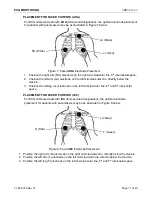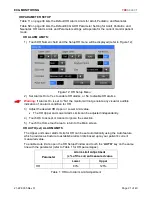
ACCESSORIES
740
SELECT
21-22-0335 Rev D
Page 31 of 40
RESPIRATION RATE MONITORING MESSAGES
Table 2 indicates the Monitor Messages associated with the RR parameter:
Message
Parameter
Value
Possible Cause
Suggested Action
RR < [lower limit]
[number]
The patient's respiration
rate has fallen below the
current lower alarm limit.
Check the patient and provide any necessary
clinical care.
Change the alarm limit if it is no longer clinically
appropriate.
RR > [upper limit]
[number]
The patient's respiration
rate has risen above the
current upper alarm limit.
Check the patient and provide any necessary
clinical care.
Change the alarm limit if it is no longer clinically
appropriate.
RR out of range
(too high)
---
The patient's respiration
rate has risen above the
maximum value the
monitor can accurately
detect.
Electrical noise from
auxiliary equipment
Monitor confused by signal
artifact
Check the patient and provide any necessary
clinical care.
Isolate the patient from auxiliary equipment, if
possible.
Check to make sure electrodes are still securely
attached to the patient, and reattach if
necessary. Remember the importance of good
skin preparation techniques.
RR lead off
[blank]
Unplugged cable
Broken cable
Loose lead wire
Faulty lead wire
Dried out electrode
Inoperable respiration
detection circuit
Intentional removal by
clinician
Check to make sure electrodes are still securely
attached to the patient, and reattach if
necessary. Remember the importance of good
skin preparation techniques.
Check to make sure all the lead wires are still
connected to the electrodes.
Check to make sure the lead wires are securely
connected to the monitor.
Check to make sure there are no broken lead
wires.
Press ALARM SILENCE in the event of intentional
removal by clinician.
Turn monitor off, then back on
If message persists, contact Zoe technical
support.
RR artifact
---
Patient movement
Electrical noise from
auxiliary equipment
Bad electrode contact
Calm the patient.
Isolate the patient from auxiliary equipment, if
possible.
Check to make sure electrodes are still securely
attached to the patient, and reattach if
necessary. Remember the importance of good
skin preparation techniques.
Table 4: Resp Monitoring Message










































